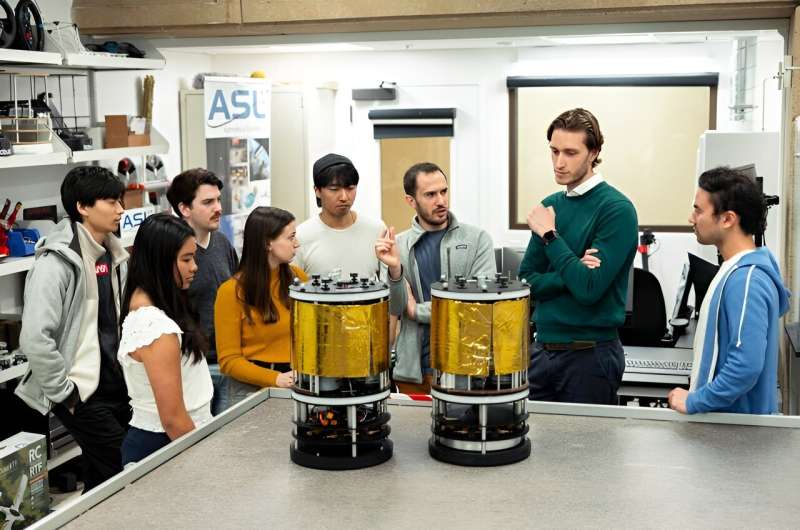OCEANOGRAPHY
Restored coral reefs can grow as fast as healthy reefs
IMAGE:
REEF STARS ARE INSTALLED IN DEGRADED AREAS TO STABILISE LOOSE RUBBLE AND KICKSTART RAPID CORAL GROWTH
view moreCREDIT: INDO-PACIFIC FILMS
Planting new coral in degraded reefs can lead to rapid recovery – with restored reefs growing as fast as healthy reefs after just four years, new research shows.
Reefs worldwide are severely threatened by local and global pressures. In Indonesia, where the study was carried out, destructive blast fishing destroyed large reef areas 30-40 years ago – with no signs of recovery until now.
The Mars Coral Reef Restoration Programme attempts to restore degraded reefs by transplanting coral fragments onto a network of interconnected “Reef Stars” (sand-coated steel frames).
Researchers studied these reefs to assess whether coral restoration can bring back the important ecosystem functions of a healthy reef.
The study was carried out by University of Exeter researchers in collaboration with the Research Center for Oceanography, National Research and Innovation Agency (BRIN) in Indonesia, Mars Sustainable Solutions and Lancaster University.
“The speed of recovery we saw is incredible,” said lead author Dr Ines Lange, from the University of Exeter.
“While reef restoration cannot solve the problem that reefs are severely threatened by climate change, it shows that active management actions can help to boost the resilience of specific reefs, and bring back important functions that are critical for marine life and local communities.”
Exeter researchers developed a method to monitor "reef carbonate budgets" – the net production or erosion of reef framework over time.
These carbonate budgets are a key predictor of the reef’s ability to grow, keep up with sea-level rise, protect coastlines from storms and provide habitat for reef animals.
To evaluate if and how fast these reef functions return after coral restoration, carbonate budgets were measured at Mars reef restoration sites that were restored a few months, one year, two years and four years ago, as well as on degraded and healthy control sites.
In the years following coral transplantation, coral cover, coral colony sizes and carbonate production rates tripled, and after four years, restoration sites were indistinguishable from nearby healthy reefs in all investigated parameters.
This means that after only four years, restored reefs are growing at the same speed as healthy reefs, provide similar habitat for marine life, and efficiently protect the adjacent island from wave energy and erosion.
However, as transplanted coral fragments are a mix of different branching coral types, the community composition on restoration sites differs from healthy reefs, which also harbour many boulder-like and encrusting corals.
This may affect habitat provision for larger marine species and resilience to future heatwaves, as branching corals are more sensitive to bleaching.
Dr Tim Lamont, from Lancaster University, who initiated the research collaboration, added: “This is a really encouraging discovery.
“If we can maintain climate conditions that allow for coral survival, it’s possible to restore even very damaged reefs back to healthy, functional systems within relatively short periods of time.”
Co-author Dr Tries Razak, from BRIN Indonesia, said: “Through this research collaboration, I am delighted to observe the highly productive partnership between a distinguished group of international scientists and our team of local scientists and Masters students in Indonesia.
“This collaborative effort not only advances scientific research in Indonesia but also contributes significantly to the capacity building for future generations of Indonesian scientists.”
Summing up her experience in Indonesia, Dr Lange added: “It was a great experience to work so closely with a diverse group of international researchers and the skilled local restoration team.
“We all learned a lot from each other.”
The paper “Coral restoration can drive rapid reef carbonate budget recovery” is published in Current Biology by Ines Lange, Tries Razak, Chris Perry, Permas Maulana, Mochyudho Prasetya, Irwan and Timothy Lamont.
A restored reef, 4 years after installing Reef Stars
CREDIT
The Ocean Agency
JOURNAL
Current Biology
ARTICLE TITLE
Coral restoration can drive rapid reef carbonate budget recovery
ARTICLE PUBLICATION DATE
8-Mar-2024
Good news for coral reef restoration efforts: Study finds “full recovery” of reef growth within four years
IMAGE:
COMMUNITIES IN INDONESIA WORK WITH MARS SUSTAINABLE SOLUTIONS TO RESTORE CORAL USING REEF STARS
view moreCREDIT: THE OCEAN AGENCY
While the majority of the world’s reefs are now under threat or even damaged potentially beyond repair, a new study reported in the journal Current Biology on March 8 offers some encouraging news: efforts to restore coral reefs not only increase coral cover, but they can also bring back important ecosystem functions, and surprisingly fast.
“We found that restored coral reefs can grow at the same speed as healthy coral reefs just four years after coral transplantation,” says Ines Lange (@InesLange9) of University of Exeter, UK. “This means that they provide lots of habitat for marine life and efficiently protect the adjacent island from wave energy and erosion.”
“The speed of recovery that we saw was incredible,” she says. “We did not expect a full recovery of reef framework production after only four years.”
The work by Lange and her international colleagues represents the first reef carbonate budget trajectories at any coral restoration sites. The study was conducted at the Mars Coral Reef Restoration Programme in South Sulawesi, Indonesia, one of the largest restoration projects in the world. The project relies on transplanting corals and adding substrate to restore reefs badly damaged by blast fishing 30 or 40 years ago. Without human intervention, those reefs had shown no signs of recovering due to the presence of loose coral rubble that prevents young coral larvae from surviving.
The restoration effort has added a continuous network of sand-coated steel structures to consolidate the rubble and offer a structure for transplanting coral fragments. The question was whether and how quickly such restored sites would recover. To find out, the researchers measured the carbonate budgets of 12 sites that had been restored at different times, up to four years ago.
“Corals constantly add calcium carbonate to the reef framework while some fishes and sea urchins erode it away, so calculating the overall carbonate budget basically tells you if the reef as a whole is growing or shrinking,” Lange says. “Positive reef growth is important to keep up with sea-level rise, protect coastlines from storms and erosion, and provide habitat for reef animals.”
They wanted to know how long it takes to bring back healthy reef growth and its associated functions. Their data show that rapid growth of transplanted corals supports the recovery of coral cover and carbonate production. In fact, just four years in, the net carbonate budget had tripled such that it matched that at healthy control sites.
There were some important differences, however. Because branched corals had been transplanted preferentially over other corals, the makeup of the restored reef communities differs. The researchers say those differences “may affect habitat provision for some marine species and resilience to future heatwaves, as branching corals are more sensitive to bleaching.”
While longer-term study is necessary to see what happens over time and under stress, the findings show that active management actions can help to boost the resilience of reefs and bring back important ecosystem functions that are critical for marine life and local communities in relatively short periods of time, according to the researchers. They’re hopeful that, over time, restored reefs will naturally recruit a more diverse mix of coral species. However, they note that what will happen in any given location around the world will depend on many factors, including environmental conditions and restoration techniques.
“As is so often the case, there is no one-size-fits-all solution, but we hope that this positive example can be used as inspiration for other reef restoration projects around the world,” Lange says.
“These results give us the encouragement that if we can rapidly reduce emissions and stabilize the climate, we have effective tools to help regrow functioning coral reefs,” says Tim Lamont (@TimACLamont), a study co-author at the Lancaster Environment Centre, Lancaster University, UK.
Reef Stars are installed in degraded areas to stabilise loose rubble and kickstart rapid coral growth
A DAMAGED CORAL REEF IN SULAWESI, INDONESIA
A restored reef, 2 years after installing Reef Stars
CREDIT
Ocean Culture Life
This work was supported by the Royal Commission, the Fisheries Society of the British Isles, and the Bertarelli Program in Marine Science.
Current Biology, Lange et al. “Coral restoration can drive rapid reef carbonate budget recovery” https://cell.com/current-biology/fulltext/S0960-9822(24)00151-9
Current Biology (@CurrentBiology), published by Cell Press, is a bimonthly journal that features papers across all areas of biology. Current Biology strives to foster communication across fields of biology, both by publishing important findings of general interest and through highly accessible front matter for non-specialists. Visit http://www.cell.com/current-biology. To receive Cell Press media alerts, contact press@cell.com.
JOURNAL
Current Biology
METHOD OF RESEARCH
Experimental study
SUBJECT OF RESEARCH
Animals
ARTICLE TITLE
Coral restoration can drive rapid reef carbonate budget recovery
ARTICLE PUBLICATION DATE
8-Mar-2024
Australia's Great Barrier Reef in grip of 'mass bleaching event'
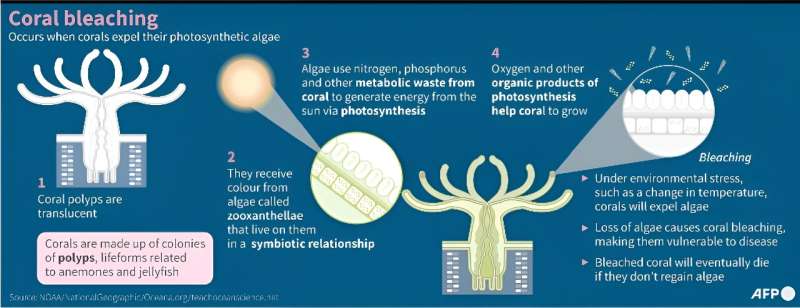
A "mass bleaching event" is unfolding on Australia's famed Great Barrier Reef, authorities said Friday, as warming seas threaten the spectacular home to thousands of marine species.
Often dubbed the world's largest living structure, the Great Barrier Reef is a 2,300 kilometre (1,400 mile) expanse of tropical corals that house a stunning array of biodiversity.
But repeated mass bleaching events have threatened to rob the tourist drawcard of its wonder, turning banks of once-vibrant corals into a sickly shade of white.
"We know the biggest threat to coral reefs worldwide is climate change. The Great Barrier Reef is no exception," Environment Minister Tanya Plibersek said in a statement.
"We need to act on climate change. We need to protect our special places and the plants and animals that call them home."
The damaging mass bleaching event—the seventh since 1998—was confirmed by government scientists following aerial surveys of 300 shallow reefs.
The Australian Reef Authority said it would now need to conduct further surveys to assess the severity and extent of bleaching.
Coral bleaching occurs when underwater temperatures are more than 1 degree warmer than the long-term average.
As corals come under heat stress, they expel algae living within their tissues—draining them of their vibrant colours.
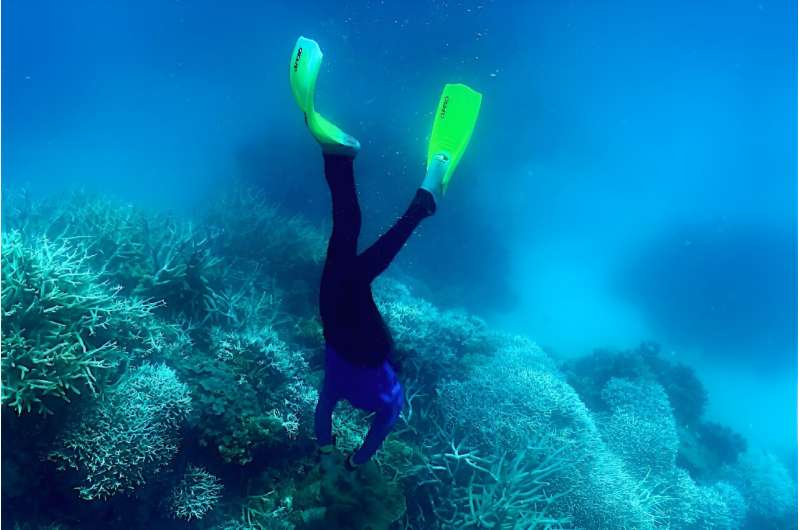
Ocean temperatures along the Great Barrier Reef have approached record levels in the past few weeks, according to official monitoring.
Richard Leck, head of oceans at World Wildlife Fund Australia, said it was likely that masses of coral would die if ocean temperatures did not cool rapidly in the coming weeks.
"This bleaching event is unfolding in an area where corals have not been previously exposed to these extreme temperatures," he said.
Leck said climate change was "putting tremendous pressure" on the Great Barrier Reef.
The current bleaching event followed similar setbacks in the Northern Hemisphere last year, Leck added, which caused major coral mortality in Florida and the Caribbean.
Some species of bleached coral have proven remarkably resilient and can recover if ocean temperatures cool.
But professor Terry Hughes, one of Australia's foremost coral reef scientists, said bleaching events were now happening so frequently that reefs were struggling to recover.
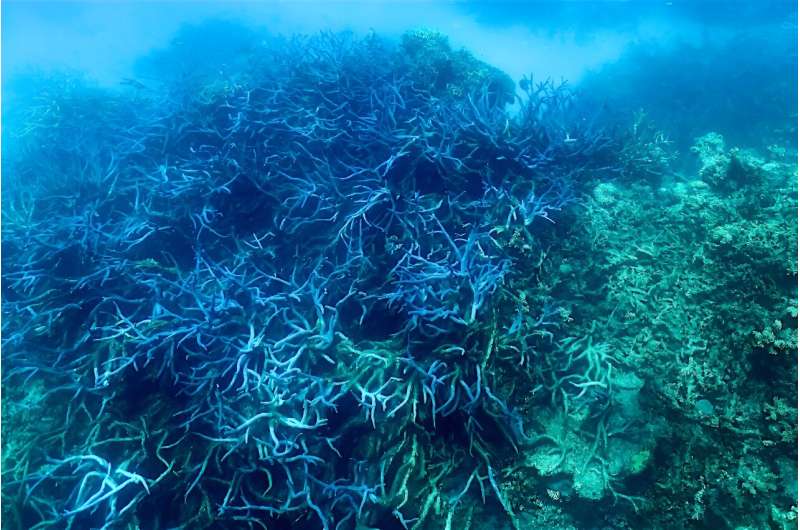
Recovery in danger
"The reef is no longer capable of recovering to the mix of coral species and the sizes of corals that were there 20 years ago," he told AFP.
"The irony is that the corals that are now prevalent on most parts of the Great Barrier Reef are fast growing and rapidly regain cover, but the kicker is that they are heat sensitive and are less tolerant to the next inevitable beaching event."
Hughes said the heat stress had increased in the past few days and would likely worsen in the coming two weeks.
The fate of the reef has been a recurrent source of tension between the Australian government and the United Nations' World Heritage Committee.
The World Heritage Committee has threatened to put the reef on a list of "in danger" global heritage sites, a move that would likely damage its allure for international tourists.
Behind-the-scenes diplomacy and fierce lobbying from Australia has so far kept it off the list.
Before this event, Australia's Great Barrier Reef suffered mass coral bleaching in 1998, 2002, 2016, 2017, 2020 and 2022.
© 2024 AFP
New technique may help scientists stave off coral reef collapse
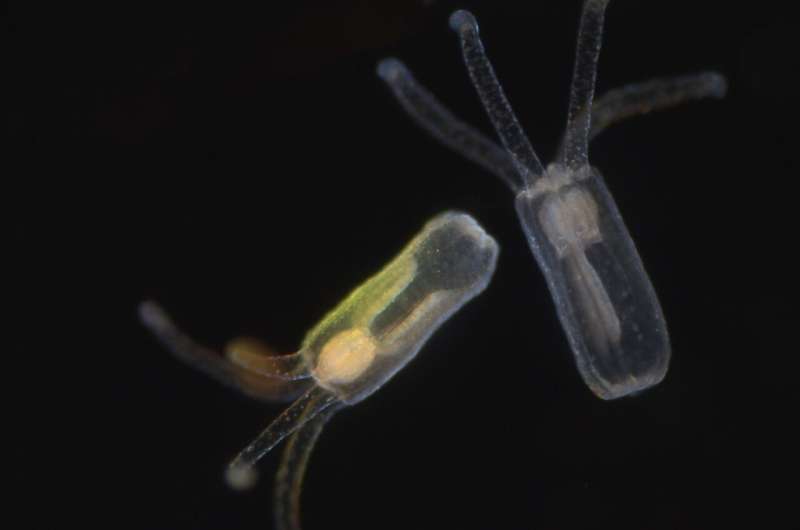
In a bit of biological magic, some tiny, jellyfish-like creatures learned eons ago how to weave seawater into durable, life-sustaining, rocky coral reefs, which provide billions in economic benefits.
But the magic is fading. In the face of warming, acidifying oceans, coral skeletons are at risk of dissolving. Scientists are racing to develop ways to help stave off collapse. But their efforts are hampered by the difficulty of studying delicate coral polyps in the lab.
In a first for helping coral polyps respond to these threats, scientists from the University of Florida have recreated the first stage of the coral skeleton creation process in a common, squishy sea anemone. The technique transforms this soft-bodied creature into the perfect lab model for researching coral skeletons and developing ways to bolster coral polyps in a changing climate.
The researchers have published their findings in the journal iScience.
"The whole ecosystem is dying. You can listen to the death all you want, but what are you going to do to fix it?" said Mark Martindale, Ph.D., director of the University of Florida's Whitney Laboratory for Marine Bioscience and supervising researcher on the study. "In order to do that, you need to understand what the problems are. And you need an experimental system to do that. Now we have that system."
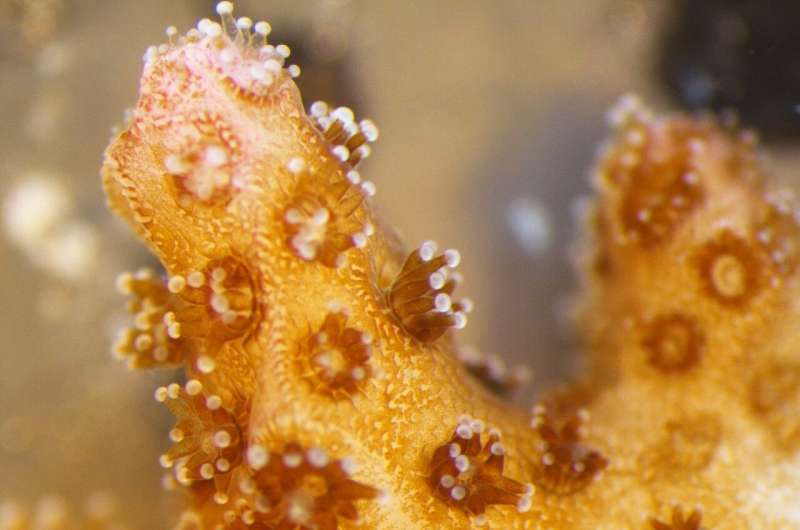
While coral polyps are reluctant to grow in the lab, the anemone Nematostella vectensis is a breeze to work with. It was the first in the family of jellyfish and corals to have its genome sequenced. Deleting or editing its genes or adding to its genome is straightforward. It has all the hallmarks of a great system for studying coral skeletons—except for the fact that it doesn't produce any skeleton
So, the Martindale lab asked the obvious question: Can we get Nematostella to act like a coral polyp and transform seawater into rock? If so, the anemone could provide a way to test fixes for wild corals.
To find out, the scientists injected Nematostella embryos with a gene from the stony coral Stylophora pistillata known for helping the animal concentrate the calcium that ultimately leads to skeleton formation. In the soft-bodied sea anemone, scientists saw the coral protein gathering up calcium and otherwise acting just as it does in the rocky coral.
Going forward, scientists can alter this gene and the others involved in coral skeleton production, tweaking their way toward creating climate-resilient coral polyps, said Brent Foster, a researcher in the lab and first author of the paper.
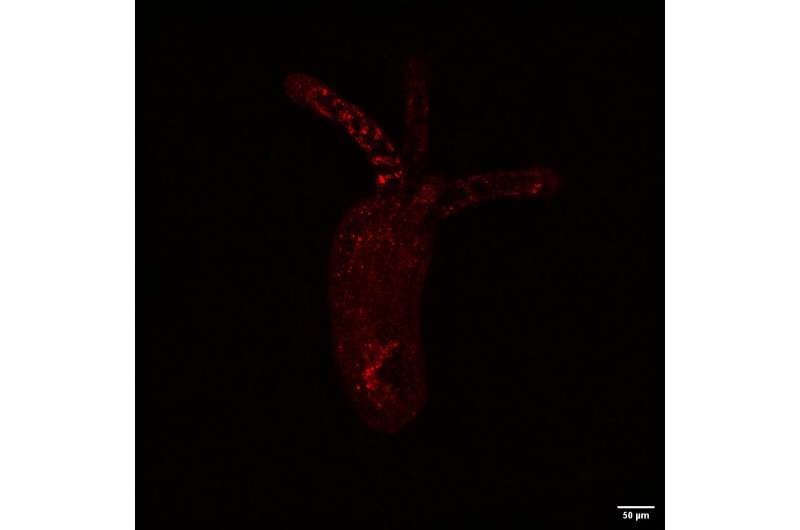
The sea anemone can be used to study other hard structures as well, even tooth enamel. These processes all fall under the umbrella of biomineralization, in which living creatures create hard structures from minerals like calcium.
"The next step is to understand how cells regulate the microenvironment that promotes biomineralization," said Federica Scucchia, a postdoctoral researcher in Martindale's lab and co-author of the report.
The Whitney Laboratory team collaborated with scientists at the Institute of Human Genetics in Montpelier, France, Cornell University and Cardiff University to complete the study.
More information: Brent Foster et al, A novel in vivo system to study coral biomineralization in the starlet sea anemone, Nematostella vectensis, iScience (2024). DOI: 10.1016/j.isci.2024.109131
The Silent Extinction Threat To Deepwater Sharks And Rays
A groundbreaking global study has shed light on the precarious situation facing deepwater sharks and rays. Led by a team of experts from around the world, the study reveals alarming statistics: one in seven deepwater sharks and rays are on the brink of extinction, according to the criteria set by the International Union for Conservation of Nature Red List of Threatened Species.
The primary threat to these deepwater giants is one similar to their shallow-water counterparts: overfishing, particularly as unintended victims of commercial fisheries targeting other species. Their meat and liver oil are prized commodities, driving a global trade that is pushing these creatures to the edge of oblivion. What makes deepwater sharks and rays particularly vulnerable is their unique biology. Spending most of their lives in the dark depths, these creatures have evolved to endure the harsh conditions of the abyss. However, their long lifespans and slow reproductive rates make them highly susceptible to overexploitation. “Many deepwater sharks and rays can only withstand very small amounts of fishing pressure”, said Dr. Nicholas Dulvy, Professor at Simon Fraser University. “Some species may take 30 years or more to mature, and possibly up to 150 years in the case of the Greenland Shark. Some only produce 12 pups throughout their entire life. Because of their relatively large size and widespread distribution, deepwater sharks and rays play a vital ecological role, concentrating and dispersing nutrients throughout deep ocean habitats.”
Dr. Rima Jabado, Deputy Chair of the IUCN Species Survival Commission and Chair of the IUCN SSC Shark Specialist Group, stresses the urgent need for action: “Our results highlight that it is time to think about regulating liver oil trade. There has been enormous success in regulating the shark fin trade but trade and fishing regulations specific to deepwater sharks and rays are urgently needed. [...] Deepwater sharks and rays have been out of sight, out of mind for too long. Now is the time to take action to prevent further endangerment.” Jabado urges for specific regulations tailored to protect these creatures, including national protections, fishing regulations, and listing species under international trade agreements like CITES.

Greenland sharks often end up as bycatch on fishing vessels, and can be considered a nuisance.
Shockingly, this study indicates that approximately 14.1% of these deep-sea dwellers face an elevated risk of extinction on a global scale. Among the 521 species scrutinized, a concerning 60 (11.5%) are currently identified as threatened, comprising nine (1.7%) Critically Endangered, 20 (3.8%) Endangered, and 31 (6.0%) Vulnerable species. This level of extinction risk represents a stark increase compared to the previous assessment conducted in 2014, more than doubling the reported threatened species count. Notably, deepwater sharks demonstrate a particularly dire situation, with 15.2% (43 of 283 species) classified as threatened, compared to deepwater rays at 7.1% (17 of 238 species). Despite the absence of species flagged as Possibly Extinct or assessed as globally Extinct or Extinct in the Wild, the phenomenon of "commercial extinction" poses a substantial threat, particularly observed among gulper sharks in regions of intense targeted fishing. Nevertheless, a significant portion of species (62.0%, n = 323) remain classified as Least Concern, while 43 species (8.3%) hover dangerously close to the brink, designated as Near Threatened. The authors believe these findings underscore the urgent need for concerted conservation efforts to safeguard the future of deepwater sharks and rays, whose decline could have profound implications for marine ecosystems worldwide. While deepwater sharks and rays are often forgotten about, their importance extends far beyond their formidable presence in the punishing depths of our ocean. These creatures play a vital ecological role, dispersing nutrients and maintaining the delicate balance of deep ocean habitats.
The researchers also explored two strategic approaches aimed at halting and reversing the declines observed among threatened deepwater sharks and rays, aligning with the Convention on Biological Diversity's "30 by 30" framework of spatial protection commitments. The first approach evaluates the advantages of implementing a global depth limit, restricting fishing activities below a designated depth (referred to as vertical refuge). The second approach assesses the benefits of establishing spatial no-take areas (referred to as horizontal refuge). A worldwide prohibition of fishing beyond 800 meters would offer 30% vertical refuge, safeguarding approximately one-third (27.4%) of threatened species. Alternatively, setting a shallower 500-meter no-fishing limit would effectively double the protection coverage, encompassing 60.8% of species. Protecting 30% of the deep ocean between 200 and 2000 meters would extend spatial (horizontal) protection to approximately 80% of species, spanning their ranges. Notable regions with significant coverage include the Gulf of Mexico and Caribbean Sea, Eastern Pacific (from western United States to Peru), Iberian Peninsula, southern Mediterranean Sea, Gulf of Aden, west India and Chagos-Laccadive Ridge, Sea of Japan and Sea of Okhotsk, and the Zealandia continent.
“Trade and fishing regulations specific to deepwater sharks and rays are needed to ensure legal, traceable, and sustainable trade and prevent further endangerment,” the team concludes. “We have the evidence to act more proactively for the deep ocean and learn from the mistakes that have driven more than half of coastal and pelagic species to be threatened. Achieving sustainable fisheries for most deepwater sharks and rays would be challenging and require high management capacity, ecological knowledge, and implementation of routine rigorous monitoring. [However,] effective precautionary actions are needed to ensure that the largest ecosystem on the planet maintains its biodiversity and that half of the world’s shark and ray species have refuge from the global extinction crisis.”
Known as the "Mother of Sharks," I'm a Latina marine biologist who has a lot of labels: science communicator, conservationist, author, educator, podcaster, television presenter. You might have seen me on Discovery Channel's Shark Week, National Geographic, BBC Wildlife, heard my TEDx talk or read my Scholastic books.
I write about sharks, the diverse people who work with them, and why both matter. As founder of The Fins United Initiative, a program that teaches audiences shark conservation and education, I find it vital that we learn to co-exist with these oceanic predators. That's why I do all that I do, and why my PhD (and outreach) revolves around human-shark interactions.
By Matt McGrath,
Share
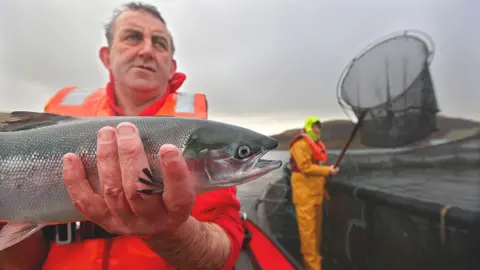
Hundreds of millions of farmed salmon have perished in mass die-offs over the past decade, say researchers.
The scientists say that large-scale mortalities are now happening more frequently and at a larger scale than ever before.
They argue that warmer seas and greater reliance on technology are contributing to the rise in deaths.
This global assessment looked at salmon deaths in some leading producers, including Norway, the UK and Canada.
But the aquaculture industry has long been controversial - with significant worries over disease among the fish, escapes to the wild and the overall environmental impact of raising them in cages.
Major mortality events, involving the sudden deaths of millions of fish have been well documented, sometimes caused by disease outbreaks but also linked to warmer seas resulting from climate change.
In Scotland last year, government data shows that more than 17 million salmon died, the most ever recorded. Producers blamed hotter oceans for the losses.
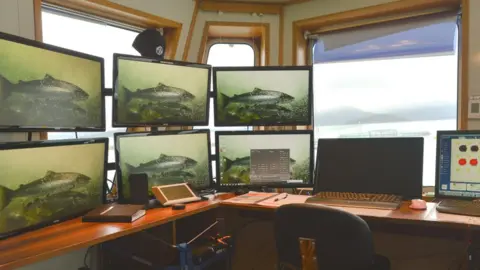
Other countries have experienced even greater mortality. Norway says close to 17% of their farmed fish died suddenly in 2023.
To shed some light on these deaths, researchers looked at data from countries producing 92% of farmed salmon over the past decade.
The scientists found 865 million instances of farmed salmon dying prematurely during this period.
They found that the frequency of the biggest die-offs was rising over time for Norway, Canada and the UK.
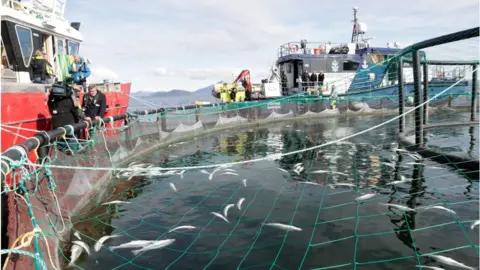
Not only were they increasing in frequency, the authors said, the die-offs were also getting bigger.
The authors estimate that the potential maximum losses for any single mass mortality event are 5.14 million fish in Norway, 5.05 million in Canada and more than one million in the UK.
A warming climate is playing a role say the authors - but so is the growing reliance on technology like underwater cameras and AI.
"An increasingly variable ocean environment, largely from climate change, may mean more production sites will be exposed to these events more often," said Dr Gerald Singh from the University of Victoria in Canada, the study's lead author.
"In addition, production practices, and technology that is increasingly pushing production into riskier conditions and allowing for greater production per site may expose larger and larger populations of fish to conditions that cause mortalities."
The authors say that technology such as remote, real-time monitoring of fish farms can help justify placing them in sites farther offshore.

However, being further offshore may increase the threats and reduce the chances of operators spotting them early. So the increased reliance on the technology actually leads to greater risks for the fish.
Campaigners against salmon farming say this new study is "alarming" and underlines the fact that human decisions as well as warmer oceans are playing a role in the discomfort suffered by the fish.
"Mortality is only one of many grave welfare concerns for farmed salmon," said Kirsty Jenkins, a policy officer at campaigners OneKind.
"They are plagued by sea lice and disease, suffer from stressful handling and treatments, and live a monotonous life in barren, crowded cages."
"The industry has shown itself to be incapable of, or unwilling to, reform, and it must be questioned if salmon farming has any place in a compassionate and sustainable food system."
Some experts wonder if the industry can survive the increasing frequency of these mass die-offs in major production centres.
Dr Singh believes that aquaculture will continue globally, but that mass die-offs with huge clean-up costs might threaten future operations in many communities.
"It's probably unlikely that these events will negate or counter food production at an aggregate global level," he told BBC News.
"Instead, these events can have considerable local effects, especially considering welfare of coastal communities and for workers."
The study has been published in the journal Scientific Reports.
Agriculture: Increasing frequency and scale of mass mortality events among farmed salmon since 2012
The frequency and scale of mass mortality events — events where large numbers of organisms die in short periods of time — among farmed salmon have increased since 2012, according to a study published in Scientific Reports.
Gerald Singh and colleagues analysed salmon mortality data from Norway, Canada, the UK, Chile, Australia, New Zealand — countries that produced over 92% of the world’s farmed salmon in 2021 — between 2012 and 2022. They identified 865 million instances of salmon mortality during this period and found that both the frequency of the top 10% highest mortality events and the maximum number of fish killed in mass mortality events within Norway, Canada, and the UK increased throughout the decade. The authors estimate that the potential maximum losses for a single mass mortality event are 5.14 million fish in Norway, 5.05 million in Canada, and over one million in the UK. They estimate that the potential maximum annual losses from mass mortality events are 8.19 million fish in Chile, 4.39 million in New Zealand, and 1.55 million in Australia.
The authors speculate that increases in the frequency and scale of mass mortality events among farmed salmon may increase with the adoption of technologies and production practices aimed at intensifying salmon production in combination with increases in the variability of ocean environments due to climate change. Examples of such technologies include using artificial intelligence and cameras to monitor fish and identify potential disease outbreaks, and conducting salmon farming in offshore or exposed sites. They suggest that while new technologies and practices intend to reduce risks for salmon farming, they may also justify production in settings that could potentially expose greater numbers of fish to hazards that can contribute to mass mortality events. In addition to the deaths of large numbers of fish, the authors caution that mass mortality events may have negative consequences for the salmon farming industry and the communities that depend on it.
JOURNAL
Scientific Reports
METHOD OF RESEARCH
Data/statistical analysis
SUBJECT OF RESEARCH
Animals
ARTICLE TITLE
Quantitative analysis of mass mortality events in salmon aquaculture shows increasing scale of fish loss events around the world
ARTICLE PUBLICATION DATE
7-Mar-2024







